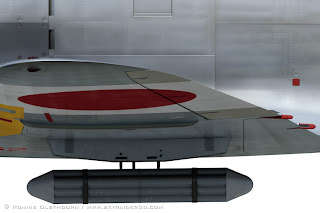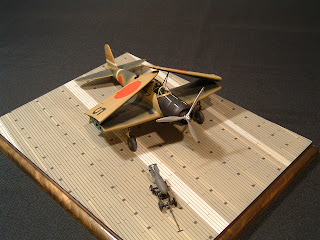The seasonal break provided an opportunity to take a closer look at this recent AZ Models kit and to compare it directly to a Pavla example. It does not appear to be just Pavla with added surface detail and an injection molded canopy. The re-working, if it is re-working, goes further than that. Whilst the basics are similar, butt-joined main components, including that intimidating separate fin without location tabs or slots, there are a number of important differences. There is a nice build of the Pavla kit here. Follow the AZ Models link to see sprue shots of their Ki-30 kit but the parts handled "in the plastic" look even nicer than that.
The JAAF version was examined but there are kits of RoCAF and RTAF variants available too. The JAAF version comes with decals for three options but the units are not identified on the colour guide on the back of the box. At top is a Ki-30 in tricolour "China" camouflage described as "sand", "dark red brown" and "Japan dark green" over "light blue grey" (of which more anon). The unit insignia is unidentified but the scheme appears to originate from Model Art # 533 'Camouflage & Markings of I.J.A. Bombers' where the colours are identified as An ryoku shoku (暗緑色 - dark green colour), Chakasshoku (茶褐色 - tea brown or dark brown colour) and Kokasshoku (黄褐色 - yellow brown colour). There is a photograph of this aircraft on p.66. The respective FS equivalents for these colours are given in the book as 34079 & 34083, 30117 & 30215 and 33434 - but please treat them with some caution. The comments accompanying the printed colour swatches in the book are translated as follows:-
Dark Green - "This colour had the opportunity to be introduced in full scale during the Japan/China incident and in the Pacific war, this colour only was used as a mainstream camouflage pattern of every kind. Although in the photo and illustration captions in the book, this colour is quoted to be used, we have to remember that there were many variations in the tone since it was used for a long period and on many types of planes. From the broad variations of FS numbers, those chosen are picked from clear colour photos of Type RO transporter, Type 97 heavy bomber etc captured by US Forces in the Philippines, New Guinea etc."
Dark Brown - "A camouflage colour used during the Japan/China incident. Actually, to understand the tone of the colour, three photos of a Type 100 heavy bomber were used, two taken by the Japanese and one by the Americans. The two photos taken by the Japanese are very old and their colour has faded remarkably while the one taken by the Americans is too yellowish, so it was very difficult to understand the exact colour. The FS numbers given are those the author is guessing."
Yellow Brown - "This colour was also used during the Japan/China incident as the above. There is not a certain tone of this colour, so the FS numbers given were decided by the author from the same colour photo taken by the Americans of the Type 100 heavy bomber (same photo as of Chakasshoku) of the 74th Sentai and various photos of Type 97 light bomber, Type 98 light bomber etc., which were artificially coloured (hand tinted monochrome photos). Generally, this is the impression of the "yellow ochre" paint."
From this it is difficult to distinguish between the formal colours known as # 30 Karekusa iro (枯草色 - dry grass colour) and # 33 Khaki iro (カーキ色) which were both "yellowish browns".
From this it is difficult to distinguish between the formal colours known as # 30 Karekusa iro (枯草色 - dry grass colour) and # 33 Khaki iro (カーキ色) which were both "yellowish browns".
Some references show the scheme as a brown with two greens, light and dark, as does the Pavla box art (above), but that might be a misinterpretation of the tricolour scheme as applied to the Ki-27, of khaki (yellowish brown), green and indigo, where the dark, greenish-blue of the indigo is perceived to be a dark blue green. Pavla's suggested colours are "Green A3" - FS 34092 or Humbrol 149 Matt Dark Green, "Brown N17" -FS 30266 and "Light Green" - FS 34423. However there are no obvious light greens in the JAAF paint colour standards to the Rikugun kokuki tosou kitei (陸軍航空機塗装規程- Army aircraft painting regulations). The undersurface is described as "Grey A/N2" - FS 36492 or Humbrol 196 Satin Light Grey.
The second option is a 31st Sentai aircraft in a scheme of "medium green" blotches over "light grey", which probably equates to the JAAF # 21 Midori iro (緑色 - green) over # 1 Hairyokushoku (灰緑色 - ash green colour). This aircraft also appears to have command stripes and a stylised eagle victory or mission marking, but the yellow wing IFF strips are unlikely on those aircraft participating in the early offensives of 1942 as they were only introduced from September 1942. JAAF # 21 was the "standard" Army green colour, a Chrome Oxide based green of strong and deep chroma with a subtle olive hue. There is no useful FS equivalent but RAL 6020 Chromoxidgrün (Chrome Oxide Green) is, unsurprisingly, similar and matched in the Revell paint range by semigloss 363 Dunkelgrün. Another closer option is White Ensign Models Colour Coats ACJ05 Nakajima Army Green.
The final option is an aircraft of the Air Academy in an unusual scheme of "Army green" in kumogata pattern over "light grey" with the green further added as a snake weave over the light grey sections. The reference source for this interesting scheme is a photograph of a derelict Ki-30 in 'Meatballs and Dead Birds' by James P. Gallagher*, but for those who want something less challenging there is a photograph of a similar Air Academy aircraft on p.65 of MA 533 in plain grey-green.
Interior colour is suggested to be "Japan Interior Green", whatever that is, but based on a snippet of research that came up with a personal description of the Ki-51 interior the cockpits of early Mitsubishi Army aircraft might have been painted a malachite green, a slightly gloomy blueish-green. There is a close RAL equivalent to the typical darker variant of this colour - 6004 Blaugrün (blue green). The closest FS 595b value is 34058 but whilst it is de-saturated, lighter and greyer, it is possibly ok for a 1/72nd model. Again, those old friends Humbrol 88 Matt Deck Green and 104 Matt Oxford Blue in combination lightened with a touch of 89 Matt Middle Blue can be used to approximate the malachite interior colours.
The Ki-30 was the Japanese Army's first single-engined light bomber and perhaps in a category to be compared to the Heinkel He-70 and Fairey Battle. I suspect the fixed undercarriage followed the same considerations as for the Ki-27. Originally conceived with a retractable undercarriage it was found the weight did not justify the reduction in drag. The original fully spatted undercarriage was altered to a half spat configuration to better facilitate maintenance on the muddy airstrips in China. This aircraft is relatively obscure in terms of documentation, there being no Maru Mechanic or FAOW on the type.
Directives were issued to Kawasaki, Mitsubishi, Nakajima and Tachikawa in February 1936 to design an aircraft to succeed the Type 93 Single Engine Light Bomber. In May, 1936, after a preliminary review of submissions only Kawasaki and Mitsubishi were instructed to produce prototypes (Kawasaki ultimately producing the Ki-32). Mitsubishi completed their prototype in February 1937, with the Ha-6 engine, but the second prototype and 16 pre-production aircraft built between September 1937 and January 1938 had the Ha-5 installed. The design was formally adopted by the JAAF in 1938 as the Type 97 Light Bomber (九七式軽爆撃機 - Kyu-Nana Shiki Kei Bakugeki-ki) abbreviated in service use to Kyu-Nana Kei-baku (九七軽爆).
Standard bomb load was 300 kg - 20 x 15 kg, 6 x 50 kg or 3 x 100 kg but with reduced fuel up to 400 kg could be carried, using both the internal bomb bay and wing racks. The AZ Models kit includes what appear to be two resin 100 kg bombs for fitting on underwing racks but there is no provision for displaying the bomb bay interior. Other resin parts are the engine (as a relief molding) and an especially nicely detailed pair of wheels. The kit also includes two injection molded canopies to allow for accidents in cutting one apart to display the open position shown in the instructions.
* Thanks Ken!
Image credits: Box art and decals © 2011 AZ Models; Box art © Pavla

















































